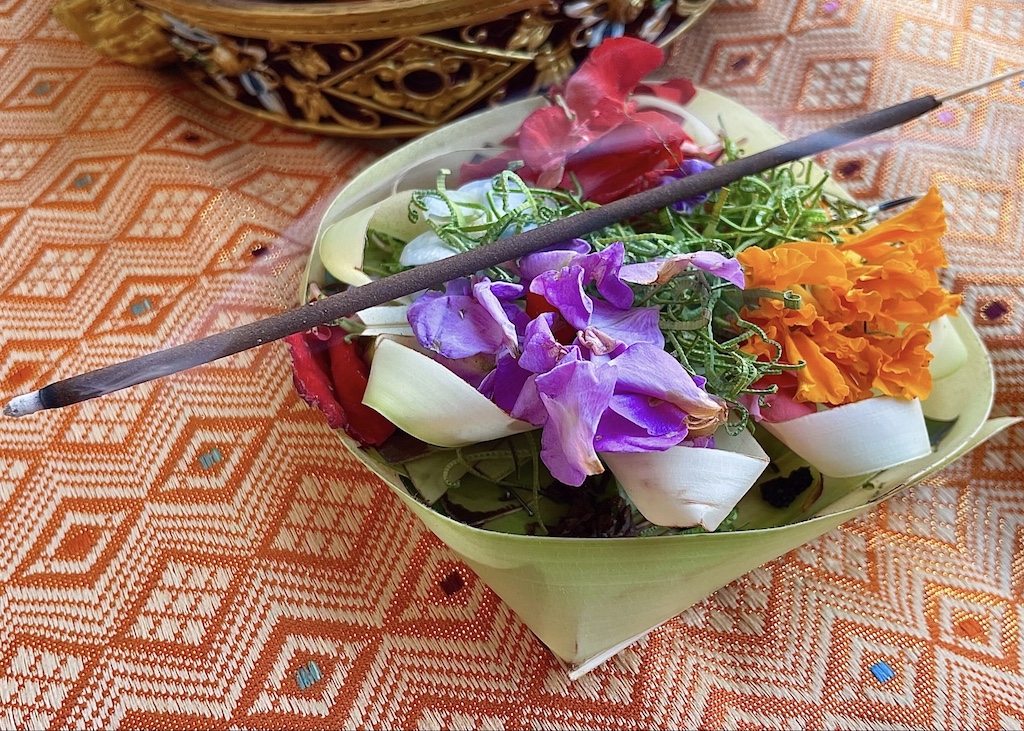Canang Sari, created by Mpu Sangkulputih, who succeeded Danghyang Rsi Markandeya at Pura Besakih, holds a crucial role in Balinese Hindu prayer rituals. Despite its small size, Canang Sari is essential (kanista=inti) because it is included in every offering or yadnya.
Commonly used in daily prayers in Bali, Canang Sari symbolizes a call to Sang Hyang Widhi, the Almighty God, and seeks the power of Widya (Knowledge) for both Bhuwana Alit (the smaller world) and Bhuwana Agung (the larger world).
The term “Canang” comes from “Can,” meaning beautiful, and “Nang,” which signifies purpose or intention in Kawi (Old Javanese). “Sari” means essence or source. Therefore, Canang Sari represents a plea for the power of Widya (Knowledge) and seeks the presence of Sang Hyang Widhi, along with His Prabhawa (manifestation), on both physical and spiritual levels.
The document also explains the various forms and functions of Canang from the perspective of Balinese Hinduism, in alignment with specific ceremonial activities. Canang is depicted through symbols derived from the Vedic language, as follows:
Canang features a square-shaped base called “ceper,” symbolizing the strength of “Ardha Candra” (the moon). On top of this base is a “Porosan,” which signifies that the offering should be made with compassion and sincerity, dedicated to Sang Hyang Widhi and His Prabhawa, while seeking His blessings and grace.
On the ceper, a stalk of sugarcane, a banana, and a slice of jaja (cake) are arranged, representing the power of “Wiswa Ongkara” (the Balinese tri-syllabic chant).
Additionally, a circular-shaped “Sampian Urasari” is used as a base for arranging flowers, symbolizing the power of “Windhu” (the Sun). Arrow-shaped decorations at the ends of the Urasari represent the strength of “Nadha” (the Stars).
The arrangement of flowers on the Sampian Urasari follows specific etiquette and tattwa, based on the designated positions of the Panca Dewata. The sequence begins with the Purwa/Murwa Daksina order, starting from the East and moving towards the South.
White flowers (or pink flowers if white ones are unavailable) are placed facing East, symbolizing a plea for the Widyadari (celestial nymph) Gagar Mayang, through the power of Sang Hyang Iswara, to sprinkle the Tirtha Sanjiwani and bestow spiritual purity.
Red flowers are arranged facing South, symbolizing a plea for the Widyadari Saraswati, through the power of Sang Hyang Brahma, to sprinkle the Tirtha Kamandalu and bestow wisdom and authority.
Yellow flowers are arranged facing West, symbolizing a plea for the Widyadari Ken Sulasih, through the power of Sang Hyang Mahadewa, to sprinkle the Tirtha Kundalini and grant intuition.
Black flowers (or blue, green, or purple flowers if black ones are unavailable) are arranged facing North, symbolizing a plea for the Widyadari Nilotama, through the power of Sang Hyang Wisnu, to sprinkle the Tirtha Pawitra and dissolve all forms of impurities in the body and soul.
Rampe flowers (sliced pandan leaves) are placed in the center, symbolizing a plea for the Widyadari Supraba, through the power of Sang Hyang Siwa, to sprinkle the Tirtha Maha Mertha and grant liberation (Moksa). The canang flower, kembang rampe, and porosan symbolize Tarung/Tedung from Ong Kara, representing the essence of Tri Bhuwana (Tri Loka) = Bhur-Bwah-Swah.


